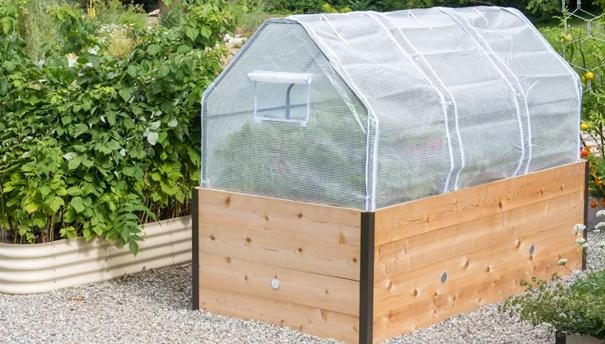Elevated raised beds allow you to garden with ease because there's no need for bending or stooping. The harvest is at a comfortable height, and often the planter can be set up right outside the kitchen door. To take advantage of these elevated gardens, I've created two theme gardens that showcase herbs, edible flowers and greens.
 The Standing Garden is made with rot-resistant cedar and has powder-coated aluminum legs. The 4-gallon self-watering tray reduces watering frequency.
The Standing Garden is made with rot-resistant cedar and has powder-coated aluminum legs. The 4-gallon self-watering tray reduces watering frequency.Herbal Tea Garden
With its compact footprint (39-1/2" L x 16-1/2" W) and self-watering reservoir, the Standing Garden is the perfect size for an herbal tea garden, featuring lemon balm, apple mint, and a selection of flavorful herbs that will provide the ingredients for delicious teas and beverages.
Position your Standing Garden where it will receive direct sunlight for at least six hours. Any less than that and your plants will not thrive. Check the water level in your garden regularly to make sure the soil does not dry out completely. During hot periods, you may have to water every day. As with all container gardens, fertilize your herbs every four to six weeks with a water-soluble fertilizer, such as PHC All-Purpose. Harvest leaves that are healthy and in good condition. Edible flowers should be picked as soon as they open.
All of the following plants will thrive in an herbal tea garden. Review the list and select six or seven, using the height and spread as your guide.
The Plants
 Lemon balm
Lemon balmLemon balm (Melissa officinalis) 36"H x 24"W, perennial Fresh or dried leaves of lemon balm provide a wonderful lemon flavor in tea and can be enjoyed alone or with other herbs. It grows to 36" in ideal conditions, but can easily be trimmed to a more compact size for this garden.
Peppermint (Mentha x piperita) 18"H x 18"W, perennial The pick-me-up flavor of peppermint stands alone in tea (hot or cold) but adds a refreshing zing to any tea blend. Mint is a fast-growing plant that spreads rapidly. Keep excess side shoots trimmed or plant in a pot that's buried to soil level.
 Roman chamomile
Roman chamomileRoman chamomile (Chamaemelum nobile) 8"H x 14"W, perennial The white flowers of Roman chamomile appear on 12" stems in late summer and are harvested for herbal teas, where they provide a slightly fruity flavor. When purchasing chamomile plants, avoid the taller German chamomile (Matricaria chamomilla) which is not generally used in teas.
Cinnamon basil (Ocimum basilicum 'Cinnamon') 24"H x 24"W, annual This variety was originally discovered in Mexico in the late 1960s. The light green leaves are distinctly veined and narrower at the tip than other basils. It grows best in full sun with plenty of water. Think sweet basil with a touch of cinnamon and you'll understand why this is a favorite of many herb tea lovers. Harvest cinnamon basil regularly to maintain a compact shape and encourage new leaf production.
 Bergamot
BergamotBergamot (Monarda didyma) 24-36"H x 24"W, perennial The flowers of this eastern U. S. native have been used as a substitute for China tea since the Boston Tea Party. The starburst-shaped flowers range from pale pink to deep red. Fresh leaves and flowers of bergamot make a delicious tea, especially with a touch of honey to sweeten it.
Ginger (Zingiber officinale) 24"H x 18"W, perennial Ginger is a perennial from the tropics. It can be grown from roots purchased at grocery stores. In spring, select firm, healthy looking rhizomes. Divide the multi-fingered root into several pieces, each with two to three growth buds. Plant with no more than half an inch of soil covering them. This exposes the root to surface warmth, which stimulates growth. The rhizome will send up leafy green stalks. Harvest a portion of the roots in fall. Tea made with gingerroot has a pleasant spicy kick. Try adding it to black tea and fruit juice for a delicious iced tea.
Apple mint (Mentha suaveolens) 18"H x 18"W, perennial An apple-scented mint with light green, fuzzy leaves, this variety makes a pleasant addition to hot or cold teas. Mint is a fast-growing plant that spreads rapidly. Keep excess side shoots trimmed or plant in a pot that's buried to soil level.
Lemon Thyme (Thymus x citriodorus) 8"H x 16"W, perennial One of the most fragrant thymes in the herb garden, lemon thyme makes a fine addtion to herbal tea blends. The fresh leaves have a calming effect, especially when combined with Roman chamomile.
 The Salad Bar Garden has a footprint of less than 6-1/2 square feet, so it's ideal for condos and townhouses with limited space for gardening. The 4-1/2" deep planting box is just right for greens and herbs. Made from rot-resistant cedar and plywood, in Vermont.
The Salad Bar Garden has a footprint of less than 6-1/2 square feet, so it's ideal for condos and townhouses with limited space for gardening. The 4-1/2" deep planting box is just right for greens and herbs. Made from rot-resistant cedar and plywood, in Vermont.Herbal Salad Bar Garden
Note to Hot-Zone Gardeners
The Salad Bar Garden is best for areas with relatively cool summers, such as USDA hardiness zone 5 and lower. For hotter zones, use the Standing Garden, which has a self-watering reservoir. Also, choose a site that has shade during the hottest part of the day.
Summer is the season for healthy, delicious salads. With the Salad Bar Garden, you can easily grow a selection of herbs to add an herbal zing to salads and dressings.
Position your garden where it will receive direct sunlight for at least four hours. Water regularly, so the soil does not dry out completely. During hot weather, you might have to water every day. As with all container gardens, fertilize your herbs every few weeks with a water-soluble fertilizer to encourage growth. Harvest leaves that are healthy and in good condition. Edible flowers should be harvested as soon as they open.
The Plants
Italian parsley (Petroselinum crispum) 12"H x 12"W, annual Parsley is a no-fuss garden herb. When added to salad dressing, it helps blend other flavors into a pleasing whole. The finely chopped leaves are also excellent sprinkled on potato or rice salads. Replant yearly for best flavor. It is actually a biennial, but the second-year leaves are bitter and it grows a 3-foot flower stalk.
Lemon Thyme (Thymus x citriodorus) 8"H x 14"W, perennial One of the most fragrant thymes in the herb garden, lemon thyme adds a pleasing burst of citrus when chopped and sprinkled on green salads or added to dressings.
Onion chives (Allium schoenoprasum) 12"H x 10"W, perennial The grass-like leaves have an unmistakable onion flavor. Pom-pom shaped blossoms appear in late spring to early summer. The finely chopped leaves or the pulled-apart flowerheads can be sprinkled on salad. When shopping, avoid garlic chives (Allium tuberosum), which grow twice as tall and have a garlic flavor.
Spicy globe basil (Ocimum basilicum 'Spicy Globe') 24"H x 24"W, annual This compact, round variety has small, narrow leaves, compared to the classic garden basil. The flavor is more spicy. Combine freshly ground leaves of spicy globe basil with olive oil and grated Parmesan cheese for a quick pesto.
Nasturtiums (Tropaeolum majus) 12"H x 16"W, annual. Note: height and spread will vary, depending on the variety you choose. Some are fairly compact; trailing varieties cascade nicely over the edge. Nasturtiums have distinctive circular leaves and trumpet-shaped, 2-3" flowers in shades of red, orange, yellow and cream. The flowers, leaves and unripe seedpods of nasturtiums are edible and have a peppery flavor. Enjoy them in a green salad or with chilled cooked vegetables. The circular leaves are also edible in salads and taste similar to watercress.
Cilantro (Coriandrum sativum) 18"H x 18"W, annual The pungent green leaves of this herb provide the signature flavor in many Southwestern and Mexican dishes. In hot climates it will bolt (go to seed) when daytime highs reach 90 degrees. Gardeners in these regions should use it as a cool-weather herb and plant it twice: once in early March and again after Labor Day. Try adding a small amount of minced cilantro to an oil-and-vinegar dressing. Cilantro leaves can also be sprinkled on a bean salad for an extra kick.
 Chervil
ChervilChervil (Cerefolium crispum) 18"H x 18"W, annual This herb is a member of the parsley family. Like parsley, it grows in a 12" tall clump of leafy stems, but the light green leaves are more delicate. In the kitchen, chervil can be used in any salad or dressing where you might otherwise use parsley.
Peppermint (Mentha x piperita) 18"H x 18"W, perennial Peppermint is the perfect herb to add to fruit salads. Try it in a yogurt-based dressing. For a Moroccan twist, combine minced peppermint with cucumber and tomato for a quick salad. Mint is a fast-growing plant that spreads rapidly. Keep excess side shoots trimmed or plant in a pot that's buried to soil level.
 Thai basil
Thai basil Summer savory
Summer savoryThai Basil (Ocimum basilicum) 24"H x 24"W, annual This type of basil has a distinctive flavor that blends well with Vietnamese and Thai cuisines. It's more aromatic than sweet basil but also more delicate in the garden. The decorative flower spikes are deep purple. Add the freshly minced leaves of this basil to Asian-flavored dressings that include ginger and sesame oil.
Summer savory (Satureja hortensis) 18"H x 18"W, annual Enjoy these leaves on bean or potato salads. Combine finely chopped summer savory, basil and thyme, and sprinkle it on fresh summer tomatoes. Drizzle with an oil-and-vinegar dressing and you have a delicious topping for bruschetta.
Salad burnet (Sanguisorba minor) 18"H x 18"W, perennial A delicious but little-known salad herb, salad burnet produces an elegant, fountain-like spray of pale green leaves. The fresh leaves have a cucumber flavor, making them an excellent addition to tossed green salads, potato salads or soups.
Garden thyme (Thymus vulgaris) 14"H x 18"W, perennial. Note: Height and spread will vary, depending on the variety you choose. Try using thyme instead of oregano in fresh dressing for a milder flavor. Add a light sprinkle of thyme leaves to pasta salad.
Overwintering
In areas with relatively mild winters, such as USDA hardiness zone 7 and warmer, the perennial herbs will return in subsequent seasons.
In colder areas, the perennials will not survive the winter in an exposed planter. You can protect them by moving the planter to a place that stays above freezing, yet remains still cool enough to allow the plants to go dormant for the winter.
Recipes
Good sources for cooking with herbs:
- Better Homes and Gardens Herb Gardening (Better Homes & Gardens)
- Herbal Tea Gardens: 22 Plans for Your Enjoyment & Well-Being by Marietta Marshall Marcin
- The Edible Salad Garden by Rosalind Creasy
- 10 Must-Have Herbs For Cooks by Ann McCormick


 Nasturtium. Learn more in the article,
Nasturtium. Learn more in the article,

